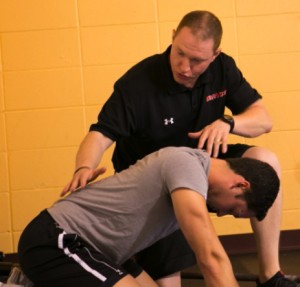
15 Lessons on Physical Preparation – Installment 2
Today, Tim Geromini and I present the second half of our “notes” on Mike Robertson’s new DVD set, Physical Preparation 101. In case you miss it, be sure to check out Installment 1. Here are eight more key takeaways:
8. Coach the heck out of the set-up.
It’s very difficult to properly perform an exercise if you don’t set up in the best position possible. If you watch Mike during the hands-on portion of this seminar, he is constantly adjusting the demonstrator until they are in the exact position he prefers. Often, your clients have the strength and mobility to perform exercises correctly, but are not in the best position to do so. It may only be a small tweak here or there, but subtle adjustments can make a huge difference. If it adds one minute on to your session, it’s a minute worth paying for.
9. Remember that clients are where they are right now.
One of the most difficult aspects of coaching can be to hold clients back when they really want to do more. I always prefer the clients who want to challenge themselves over the ones you have to convince to train harder. However, emphasizing quality over quantity isn’t always easy. Make sure you let the client know we are looking for quality reps.
10. You can have a template, but treat everybody as an individual.
Mike’s R7 approach is a template, but all clients are treated individually. Too often in the strength and conditioning industry we see cookie cutter programs that are a “one size fits all” approach. For instance, those with flat thoracic spines and an extended low back are treated the same as someone with significant kyphosis and flat lumbar spine. A template serves as an organized structure for which individuals can improve. Sure, everybody who trains at IFAST will have the R7 template as part of their program, but the exercises are tailored to each individual.
11. Be an efficient coach.
When you are working with a client, you should a) name the exercise, b) describe why they’re doing it, c) demonstrate the lift, and d) coach the lift. These can all be accomplished in under 20 seconds and makes all the difference. When a client knows why they are doing an exercise, they now have ownership of it. You’ll also save yourself a lot of time in the future if the client knows the name of each exercise so they don’t have to keep asking you.
12. Coaching angles matter.
If you master the sagittal plane, the frontal and transverse planes are easier to coach. Make sure you coach from 90-degree angles; there is a lot you can miss if you aren’t in the best position to coach. The “90-degree rule” also tells us that there are times when two coaches (one front/back and one left/right) can get the coaching job done faster than just one.
13. Think of yourself as a doctor of exercise.
When you’re a qualified expert, people come to you because you’re the best. Now, this also takes into consideration the work you are willing to put in to improve your assessment and programming process. However, you should understand we are not just writing down numbers on a sheet of paper and hoping it’ll work. You put in the time to learn the client’s movement patterns and compensations.
14. Remember that aerobic work has its place.
Cardiovascular health and parasympathetic dominance are important goals in any training (and recovery) program. People are far too sympathetic dominant, essentially in today’s upbeat world, where there is no “off” switch. Mike cites the equation of “Anaerobic threshold – resting heart rate = aerobic window.” In other words (and quite obviously), the higher your resting heart rate, the greater your opportunity for improvements. In recent years, though, everyone seemed to want to just push the left side of the equation (anaerobic threshold) with loads of interval training.
If you can widen the aerobic window, you’ve done a lot of good things for the client even beyond just cardiovascular health. High intensity anaerobic exercise is built from a low intensity aerobic foundation, so get your “easy” gains first. Over the long haul, when you are more resistant to fatigue, you can handle more volume and recover easier.
15. Make sure clients can keep the pelvis square as they load the hips.
The biggest benefit to split-stance and single-leg work is turning the right things on and turning the wrong things off. Most people look like wounded animals when performing single-leg work, but those who perform single-leg and split-stance exercises correctly are generally improving hip mobility and strength – and most importantly, doing so without compensation.
As a friendly reminder, Physical Preparation 101 is now on sale, and it’s an excellent resource for your training library. You can learn more HERE.






